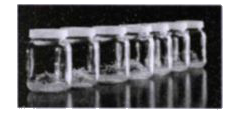If the bacteria in a culture increase continuously at a rate proportional to the number present and initial number is N, then the number present at time t is
2Nekt
N4ekt
Nekt
N2ekt
The correct Answer is:C
Step by step video, text & image solution for If the bacteria in a culture increase continuously at a rate proportional to the number present and initial number is N, then the number present at time t is by Maths experts to help you in doubts & scoring excellent marks in Class 12 exams.
Updated on:21/07/2023Topper's Solved these Questions
- DIFFERENTIAL EQUATIONSBook:MARVEL PUBLICATIONChapter:DIFFERENTIAL EQUATIONSExercise:TEST YOUR GRASP
Explore 14 Videos
- DIFFERENTIAL EQUATIONSBook:MARVEL PUBLICATIONChapter:DIFFERENTIAL EQUATIONSExercise:TEST YOUR GRASP
Explore 14 Videos
- CONTINUITY F FUNCTIONSBook:MARVEL PUBLICATIONChapter:CONTINUITY F FUNCTIONSExercise:MULTIPLE CHOICE QUESTIONS
Explore 131 Videos
- DIFFERENTIATIONBook:MARVEL PUBLICATIONChapter:DIFFERENTIATIONExercise:MULTIPLE CHOICE QUESTIONS (TEST YOUR GRASP - II : CHAPTER 11)
Explore 24 Videos
Similar Questions
The rate of increase of the bacteria in a culture is proportional to the number of bacteria present and it is found that the number doubles in 6 hours. Prove that the bacteria becomes 8 times at the end of 18 hours.
View SolutionIn a certain culture of bacteria, the rate of increase is proportional to the number present. If it is found that the number doubles in 4 hours, find the number of times the bacteria are increased in 12 hours.
View Solution
Knowledge Check
The rate of increase in the number of bacteria in a certain bacteria culture is proportional to the number present. If in 5 hrs the number triples, then in 10 hrs, the number of bacteria present is
A18 times the originalB12 times the originalC6 times the originalD9 times the originalRead the following text and answer the following questions on the basis of the same: The rate of increase in the number of bacteria in a certain bacteria culture is proportional to the number present. Given that the number triples in 5 hours.

The bacteria becomes 10 times in ___________ hours.A5log7B5log10log3C5log3Dlog(1053)The rate of increase in the number of bacterai in a certain becteria culture is propotional to the number present at that time. If is found that the number doubles in 4 hours, then at the end of 12 hours, the number of bacteria are
A4 times the originalB6 time the originalC8 times the originalD10 times the original
In a certain culture the number of bacteria at any instant increases at a rate proportional to the cube root of the number present at that instant. If the number becomes 8 times in 3 hours, when will the number be 64 times?
View SolutionThe population of a village increases continuously at the rate proportional to the number of its inhabitants present at any time. If the population of the village was 20,000 in 1999 and 25000 in the year 2004, what will be the population of the village in 2009?
View SolutionThe population of a village increases continuously at the rate proportional to the number of its inhabitants present at any time. If the population of the village was 20, 000 in 1999 and 25000 in the year 2004, what will be the population of the village in 2009?
View SolutionRead the following text and answer the following questions on the basis of the same: The rate of increase in the number of bacteria in a certain bacteria culture is proportional to the number present. Given that the number triples in 5 hours.

The general solution is _________ .
View SolutionRead the following text and answer the following questions on the basis of the same: The rate of increase in the number of bacteria in a certain bacteria culture is proportional to the number present. Given that the number triples in 5 hours.

If 'N' is the number of bacteria, the corresponding differential equation is ____________ .
View Solution

